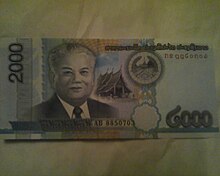Kaysone Phomvihane
Kaysone Phomvihane | |
|---|---|
ໄກສອນ ພົມວິຫານ | |
Khamtai Siphandon | |
| Personal details | |
| Born | Nguyễn Cai Song 13 December 1920 Savannakhet, French Indochina |
| Died | 21 November 1992 (aged 71) Vientiane, Laos |
| Political party | Lao People's Revolutionary Party |
| Spouse | Thongvin Phomvihane |
| Relatives | Santiphap (son) Sanyahak (son) Saysomphone (son) Thongsavanh (son) |
| a. ^ General Secretary of the Central Committee of the Lao People's Party until February 1972; General Secretary of the Central Committee of the Lao People's Revolutionary Party until March 1991; Chairman of the Central Committee of the Lao People's Revolutionary Party since March 1991 | |
Kaysone Phomvihane (
Biography



Kaysone was born Nguyễn[
He attended law school at
He became an active revolutionary while studying in Hanoi during the 1940s, establishing the Lao People's Liberation Army (LPLA) on 20 January 1949 and becoming the Minister of Defense of the Resistance Government (Neo Lao Issara) from 1950. In 1955, he was instrumental in setting up the LPRP at Xam Neua in the north, and subsequently served as the Pathet Lao leader. For several years, he mostly stayed in the background, with Prince Souphanouvong serving as the Pathet Lao's figurehead. In the years which followed, he led communist forces against the Kingdom of Laos and U.S. forces.
Kaysone came out of the shadows in December 1975, shortly after the Pathet Lao took Vientiane, and seized control of the country. At a National Conference of People's Representatives that opened on December 1, Kaysone declared the abolition of the monarchy and the establishment of a republic. The following day, on a motion by presiding officer Kaysone, the National Conference accepted King Sisavang Vatthana's abdication, abolished the monarchy, and proclaimed the Lao People's Democratic Republic. Kaysone nominated Souphanouvong as first president, while he was named prime minister, which he held until becoming president in 1991. Along the way, he married Thongvin Phomvihane.
Under Kaysone's watch, the process of demarcating the border between Laos and Vietnam started in 1977 and finished in 2007. According to Western journalists, the border is "very close" to the 1945 French-made border between Laos and Annam.
According to Vatthana Pholsena, assistant professor of Southeast Asian Studies at the National University of Singapore and author of the book "Post-War Laos", Kaysone was "the top policy maker and a strongman in the LPDR". He created
Kaysone died in Vientiane on 21 November 1992. After his death, the government of Laos built a museum in his honor, partially funded by Vietnam.[4]
In 2012, his cremated ashes were transferred from their original resting place to the newly built National Cemetery.[5]
Family
Kaysone had four sons:
Foreign honours
 Thailand: Knight of the Order of the Rajamitrabhorn
Thailand: Knight of the Order of the Rajamitrabhorn Cuba: Grand Cross of the Order of José Martí
Cuba: Grand Cross of the Order of José Martí Gold Star Order
Gold Star Order Philippines: Grand Collar of the Order of Sikatuna
Philippines: Grand Collar of the Order of Sikatuna Indonesia: Star of the Republic of Indonesia, 1st Class
Indonesia: Star of the Republic of Indonesia, 1st Class Austria: Grand Star of the Decoration of Honour for Services to the Republic of Austria
Austria: Grand Star of the Decoration of Honour for Services to the Republic of Austria Soviet Union:
Soviet Union:
See also
References
- ^ "English Dictionary - Grammar - Phomvihane". Collins English Dictionary. Archived from the original on 8 December 2023. Retrieved 8 December 2023.
- ISBN 0-7494-1069-8, pg 117
- ISBN 0-253-33854-9, pg 181
- ^ "Former President Kaysone Phomvihane Memorial Museum". Visiting Arts, Laos Cultural Profile. Archived from the original on December 25, 2007. Retrieved 2007-09-10.
- ^ Tappe, Oliver (6 April 2012). "Revolutionary remains". New Mandala. Retrieved 23 February 2021.
- ^ "Rising Laos political star dies". Retrieved 28 July 2018.


